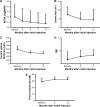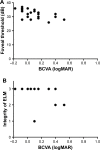Foveal threshold and photoreceptor integrity for prediction of visual acuity after intravitreal aflibercept on age-related macular degeneration
- PMID: 29713139
- PMCID: PMC5907895
- DOI: 10.2147/OPTH.S156162
Foveal threshold and photoreceptor integrity for prediction of visual acuity after intravitreal aflibercept on age-related macular degeneration
Abstract
Purpose: To determine whether baseline foveal threshold and photoreceptor integrity can predict best-corrected visual acuity (BCVA) at 12 months after intravitreal aflibercept (IVA) therapy in eyes with neovascular age-related macular degeneration (AMD).
Patients and methods: We evaluated 25 eyes of 25 patients with treatment-naïve neovascular AMD who received IVA once a month for 3 months, followed by once every 2 months for 8 months. BCVA, integrity of the external limiting membrane (ELM) or the ellipsoid zone (EZ) of the photoreceptors, and retinal sensitivity were determined before (baseline) and at 6 and 12 months after initial IVA. The average threshold foveal sensitivity and mean deviation within the central 10° were determined by Humphrey central 10-2 perimetry. Correlations between BCVA at 12 months and integrity of the ELM or EZ, foveal threshold, and mean deviation at each visit were determined.
Results: At 12 months, BCVA improved significantly from 0.20±0.23 to 0.10±0.22 logMAR (logarithm of the minimum angle of resolution) units, and foveal threshold and mean deviation improved significantly from 29.0±5.1 and -3.38±3.10 dB to 32.6±3.2 and -1.64±2.10 dB, respectively (P=0.0009 and P=0.0021). At baseline, both foveal threshold and integrity of the ELM were significantly correlated with BCVA at 12 months (P=0.0428 and P=0.0275).
Conclusion: These results indicate that both integrity of the ELM and foveal threshold at baseline can predict BCVA after treatment for neovascular AMD. There is a possibility that these parameters can predict the efficacy of IVA in each case.
Keywords: aflibercept; age-related macular degeneration; foveal photoreceptor integrity; foveal threshold.
Conflict of interest statement
Disclosure The authors report no conflicts of interest in this work.
Figures





Similar articles
-
Improvements of Retinal Sensitivity after Intravitreal Injection of Aflibercept in Eyes with Neovascular Age-Related Macular Degeneration with or without Polypoidal Choroidal Vasculopathy.Ophthalmologica. 2021;244(4):347-360. doi: 10.1159/000517187. Epub 2021 May 20. Ophthalmologica. 2021. PMID: 34015785
-
Effects of Intravitreous Aflibercept Injection in Pachychoroid Neovasculopathy: Comparison with Typical Neovascular Age-Related Macular Degeneration.Clin Ophthalmol. 2021 Apr 13;15:1539-1549. doi: 10.2147/OPTH.S285257. eCollection 2021. Clin Ophthalmol. 2021. PMID: 33883872 Free PMC article.
-
Restoration of Outer Retinal Layers After Aflibercept Therapy in Exudative AMD: Prognostic Value.Invest Ophthalmol Vis Sci. 2015 Jun;56(6):4129-34. doi: 10.1167/iovs.15-16735. Invest Ophthalmol Vis Sci. 2015. PMID: 26114491
-
Long-term reconstruction of foveal microstructure and visual acuity after idiopathic macular hole repair: three-year follow-up study.Br J Ophthalmol. 2019 Feb;103(2):238-244. doi: 10.1136/bjophthalmol-2017-311689. Epub 2018 Apr 9. Br J Ophthalmol. 2019. PMID: 29632001
-
Importance of Central Retinal Sensitivity for Prediction of Visual Acuity after Intravitreal Bevacizumb in Eyes with Macular Edema Associated with Branch Retinal Vein Occlusion.PLoS One. 2016 Feb 17;11(2):e0149246. doi: 10.1371/journal.pone.0149246. eCollection 2016. PLoS One. 2016. PMID: 26885822 Free PMC article.
Cited by
-
Managing Neovascular Age-Related Macular Degeneration in Clinical Practice: Systematic Review, Meta-Analysis, and Meta-Regression.J Clin Med. 2022 Jan 10;11(2):325. doi: 10.3390/jcm11020325. J Clin Med. 2022. PMID: 35054021 Free PMC article. Review.
-
Lamellar Macular Holes: The Role of Microperimetry in Functional Assessment.J Ophthalmol. 2019 Apr 14;2019:9035837. doi: 10.1155/2019/9035837. eCollection 2019. J Ophthalmol. 2019. PMID: 31098326 Free PMC article.
-
Reliability of Subjective Assessment of Spectral-Domain OCT Pathologic Features by Multiple Raters in Retinal Vein Occlusion.Ophthalmol Sci. 2021 Jun 5;1(2):100031. doi: 10.1016/j.xops.2021.100031. eCollection 2021 Jun. Ophthalmol Sci. 2021. PMID: 36249305 Free PMC article.
References
-
- Wong TY, Chakravarthy U, Klein R, et al. The natural history and prognosis of neovascular age-related macular degeneration: a systematic review of the literature and meta-analysis. Ophthalmology. 2008;115(1):116–126. - PubMed
-
- Heier JS, Brown DM, Chong V, et al. VIEW 1 and VIEW 2 Study Groups Intravitreal aflibercept (VEGF trap-eye) in wet age-related macular degeneration. Ophthalmology. 2012;119(12):2537–2548. - PubMed
-
- Schmidt-Erfurth U, Kaiser PK, Korobelnik JF, et al. Intravitreal aflibercept injection for neovascular age-related macular degeneration: ninety-six-week results of the VIEW studies. Ophthalmology. 2014;121(1):193–201. - PubMed
LinkOut - more resources
Full Text Sources
Other Literature Sources
Miscellaneous

